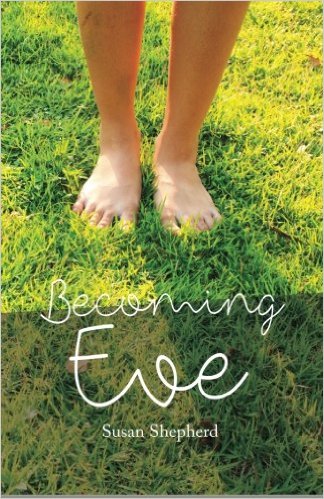SUSAN SHEPHERD|GUEST
The following is an excerpt from Susan Shepherd’s book, Becoming Eve.
It’s not easy being green
My brothers grew up watching Sesame Street. The series that premiered in the fall of 1969 continued its influence on my own children in the early ‘80’s. One of our favorites has always been Kermit the Frog. His angsty, lyrical ballad, “It’s not easy being green,” was included on the first Sesame Street album that entertained our family when my brothers were little and I can still sing the lyrics today.
“It’s not that easy being green. Having to spend each day the color of the leaves…”
Kermit’s song was about being green. The color. Really, green. He was bemoaning the “blandness” of his skin (is it really skin, on a frog?) and wishing that his were a flashy color. Like red or gold.
I looked up the word “green”. Webster lists nine definitions for the adjective that are consistent with Kermit’s use of the word. It’s tenth definition reads: “relating to or being an environmentalist political movement; concerned with or support environmentalism…”
When did “green” stop being just a color? When did it become the representation of an environmentalist policy? Kermit must be glad to know that now it is popular and desirable to be green.
Lots of words that meant one thing when I was in elementary school have new meanings today.
Fly…
Beef…
Crack…
Grill…
So we find ourselves forced to adapt to the new use of these and myriad other words – or we just don’t use them at all…
Ezer, “helper” is not one of those words. We are not in a position to redefine the Word of God. We cannot avoid or replace the language that He has used.
Becoming Eve means recovering our understanding of being an ezer from God’s heart and mind, not our own…
[It is true that] the current cultural definition of the word “help” means passive. Subservient. Inferior. Small.
However, as we thoughtfully consider this word as God uses it to describe Himself, the God of the Universe, such descriptions are without merit. The word ezer as it is employed in the Bible supplies a picture of God’s strength, of His power, of His vitality and wisdom. It informs our theology as it illustrates for us a God who is quick to rescue, to protect, to comfort, and to support.
We think of a helper as one who is weak. But this is God, our helper: “Who is this King of Glory? The Lord, strong and mighty” (Psalm 24:8)
We think of a helper as one who is inferior. But this is God, our helper: “God reigns over the nations; God sits on His holy throne” (Psalm 47:8)
We think of a helper as one who is ignorant and simple. But this is God, our helper: “O Lord, how manifold are your works! In wisdom you have made them all” (Psalm 104:24)…
This is God. He is our ezer. With few exceptions, this word in Scripture is used primarily for God. And, in the Genesis account of creation, for Adam’s new bride. And for you. Ezer.
More than a Hat
When my children were at home, my friends and I would often discuss the various “hats” that we exchanged throughout a typical day. From the chef hat, to the taxi driver, to teacher, to counselor, to nurse. Some were everyday hats. Others we donned just for special occasions.
My single friends have “hat wardrobes.” Emily wears her teacher hat, her friend hat, her daughter hat, her roommate hat, her leadership team hat, her counselor hat and her new sister-in-law hat. Candi adds her softball team player hat. Jill adds her home owner/landlord hat.
As we consider what it means to be uniquely feminine, to live with ezer-like faith by design, we need to see that ezer is more than another hat we wear. It’s not another role we’ve been given, or a category for thing that we do. John Piper defines living with this perspective of God’s design and promises a “disposition”. He suggests that it “expresses itself in many different ways depending on the situation… The specific acts that grow out of the disposition vary considerably from relationship to relationship, not to mention culture to culture.” (What’s the Difference, page 51)
Faith that demonstrates itself in the helper disposition is a feminine expression that applies to every season, every circumstance and every arena of life – every “hat”. This is what God had in mind when He fashioned the woman from Adam’s rib. …
Our goal here is not to define a specific set of behaviors. What we must do is discover true femininity that accords with the truth of God’s purpose as it was set forth in creation and as it resonates throughout Scripture. The “helper” design has more to do with attitude, heart, and perspective than about a list of things to do (or not do). It applies whether I am wearing my chef hat, my teacher hat, my director-of-women’s-ministry hat, or my wife-of-Chas hat.
To get your own copy of Becoming Eve, click here.
 Susan is the Director of Women’s Ministries at Christ Covenant Church in Matthews, North Carolina. Her first book, Becoming Eve, is now available along with a study guide for personal and small group use. She and her husband, Charles, have two married children and two grandsons. While Susan loves cooking, photography, reading, writing and ministry, she mostly loves being Gigi to Micah (2) and Jack (8 months)!
Susan is the Director of Women’s Ministries at Christ Covenant Church in Matthews, North Carolina. Her first book, Becoming Eve, is now available along with a study guide for personal and small group use. She and her husband, Charles, have two married children and two grandsons. While Susan loves cooking, photography, reading, writing and ministry, she mostly loves being Gigi to Micah (2) and Jack (8 months)!

